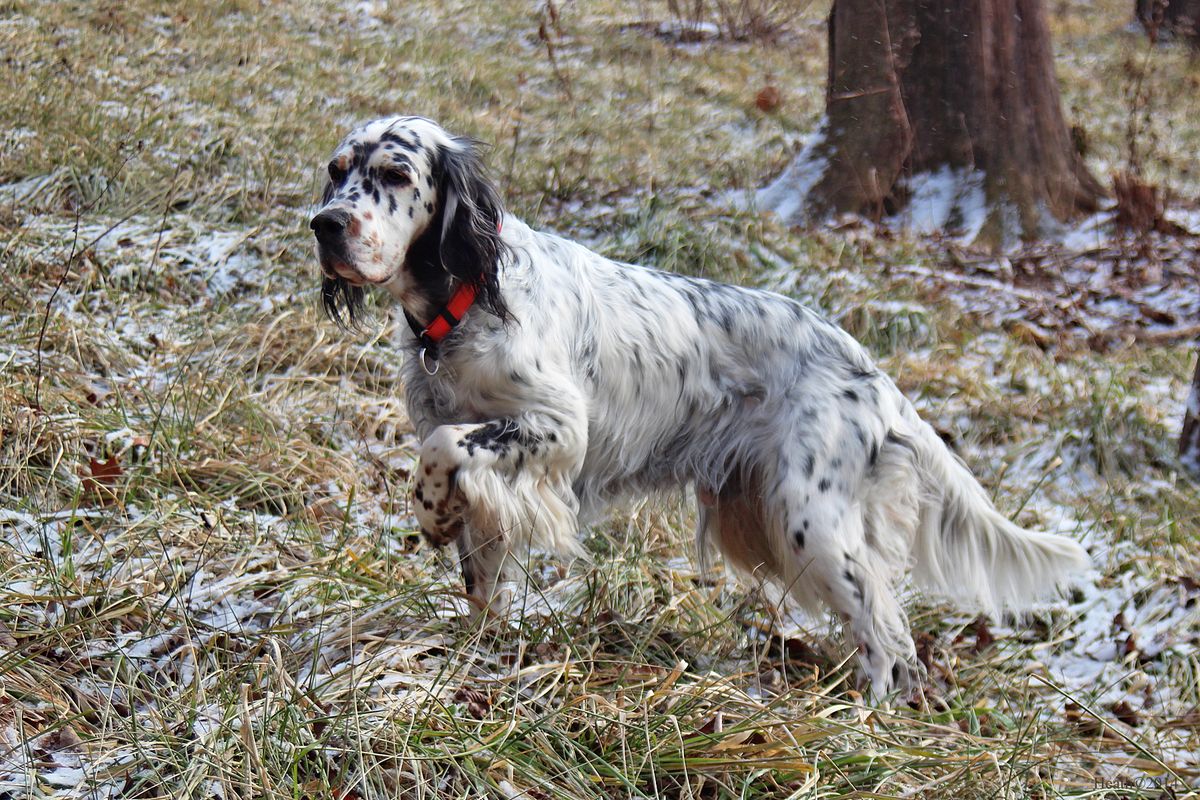Article: The Belton Pattern: An English Setter’s Inheritance

The Belton Pattern: An English Setter’s Inheritance

The dog’s soft, silky coat hair blows wistfully alongside the tall grass and meadow flowers. One of the four distinct Setter breeds, English Setters are often considered both cute and elegant, in large part thanks to their stunning appearance. With their sweet temperament and adorably soft features, the sporting dog is the full package of friendly, adventurous and adorable canine companions. The English Setter’s distinct markings make the breed as striking as it is affectionate. The dog effortlessly combines grace, beauty, and goofy, lovable characteristics. With feathery soft fur, floppy ears, and a slightly sloping, narrow shaped head, the English Setter, complete in all of its coat patterns and types - can easily exude both sophistication and sport.
The English Setter is believed to have originally been bred by crossing Spanish Pointers, large water Spaniels and Springer Spaniels. In particular, Edward Laverack and Richard Purcell Llewellin of the UK are credited with establishing much of the English Setter’s breeding during the 19th century. Where Edward Laverack sought refinement and poise, Richard Purcell Llewellin bred for stamina in the field. These two visions shape the breed we know today. Later, when the breed made it to the United States, a C.N. Myers of Hanover, Pennsylvania furthered the breed’s development as a hunting dog overseas.Through the efforts of the aforementioned individuals and with years of thoughtful effort and development of the breed, we are left with the beautifully tempered, physically agile and stunning English Setter, complete with their one-of-a-kind “belton” coat patterns.
Indeed, in parallel to the dedication of such breeders, the Setter has been celebrated across art and literature for centuries, an easy subject to include in 18th and 19th century works showcasing hunting and estate life of aristocratic living.. The English Setter’s elegant appearance and history as a sporting, hunting and working dog have been favorite themes for artists such as Edmund Henry Osthaus, Thomas Blinks, Sawrey Gilpin and John Emms. Literary works featuring the Setter such as Jenny Willow: A Novel by Mike Gaddis and Anne Brontë: The Tenant of Wildfell Hall also portray the dog existing within long established sporting culture with the gentry.
“Belton” - a term borrowed from a Northumberland village, the word feels as old as the stone walls and church bells flecked across this northeastern coast in England. “Belton” uniquely describes the English Setter, and refers to their predominantly white coat with shades or speckles of another color. The speckled coat patterns gives these dogs the marbled, spotted-like appearance so well known and adored! English Setters can come with four ‘belton’ patterns: liver, lemon, orange, and blue. There may also be a tricolor combination with a blue belton base and tan points. As a pup, an English Setter begins in a snowy garb, its future markings begin hidden. As weeks pass, their speckling appears, freckles bloom, until their adult coat comes to full fruition like a painting on an artist’s canvas.
The Coats
Blue Belton

White coat base with black ticking; this bluish-gray smattering exudes a smoky hue of mystery and charm. The belton speckles are reminiscent of black diamonds, intentionally placed across the dog’s silky coat.
Orange Belton

White coat base with orange flecks/ticking. This coat has no black pigmentation anywhere and can often appear reddish. As a puppy, a Setter with this light-toned coloring maintains their silly, youthful appearance. As the dog ages, the copper orange may deepen into a more burnt red, giving the Setter a sage and glowing appearance fitting for the highlands of neighboring Scotland!
Lemon Belton

This coat color can be rare! Similar to the orange belton, this coat pattern is lighter and more diluted and may come off as tan or beige. The color of their pale brown spots blend easily into their white coats, and the pinkish nose and eyes contribute to their pale gold appearance, like sunlight flooding into a crisp conservatory.
Liver Belton

Last but not least, the liver belton coat refers to liver or chocolate brown flecks, often found with brown rims around the dog’s eyes and nose. The chocolate brown spots look as dainty and delicious as they’re described, and the warm hue of their brown markings are reminiscent of a Yorkshire tea bag dunked into a warm cuppa!
For over 400 years, the English Setter has coursed across fields with the elegance of dancers and slumped by the hearth with the goofy grin of clowns. It is in this duality, grace and foolishness stitched together that the English Setter has charmed us for centuries.

Written by Kenalyn Ang, this article was inspired by Enid Blythe’s founder, Elizabeth, whose childhood was filled with the presence of Setters. As the brand looks ahead, the question arises: might the next Enid Blythe mascot be a Setter? Only time will tell.


Leave a comment
This site is protected by hCaptcha and the hCaptcha Privacy Policy and Terms of Service apply.